
FAQs for People with Type 1 Diabetes
Don’t let your questions about your Type 1 Diabetes go unanswered! We’ve got you covered.
Q: What caused my Type 1 Diabetes?
A: According to the CDC, Type 1 diabetes is considered an auto-immune disease where the immune system mistakenly begins attacking the insulin-producing (beta) cells of our pancreas. Some people have genes that increase their risk of developing type I diabetes. Although diabetes isn’t a curable disease, it can definitely be treated.
Q: Will exercise help control my diabetes?
A: In general, exercise can be helpful when managing type 1 diabetes, in addition to taking insulin and eating a healthy diet. In general it is recommended that people with diabetes should try to get 150 minutes per week of exercise. You can think of this as exercising about 4 to 5 times per week for 30 – 40 minutes. Always speak with your doctor about exercise guidelines specific to you before getting started.
Q: Do I always need to monitor my blood sugar, even if I’m feeling fine?
A: It’s always best to monitor your blood sugar levels, even if you’re feeling fine. Feeling fine is not a guaranteed indicator that your blood sugar levels are in their target range. Sometimes these symptoms can appear later or the lack of monitoring can lead to other “hidden” complications. You can monitor your blood sugar levels by using a meter or continuous glucose monitor (sensor). Consult your doctor if your blood sugar levels are out of range or for advice on management.
Q: What do I do if I have hypoglycemia or low blood sugar?
A: Mild to moderate blood sugar levels can make you feel shaky, nervous, start sweating, feel chills, irritability, nausea, etc.. If you experience a mild to moderate episode of low blood sugars you should follow these steps:
- Consume 15 g of simple carbohydrates if blood glucose is 50–70 mg/dL.
- Wait 15 minutes
- Check your blood sugar levels again
- If the level is still <70 mg/dL, repeat steps 1–3.
- Repeat until blood glucose is >70 mg/dL and then consider eating a snack or small meal to keep levels from dropping again
You may also need to use glucagon.
Q: How do I reach my goal A1C?
A: According to the American Diabetes Association, there are 4 key ways to improving your A1C.
- Finding the right timing of meals and snacks that works in the person’s life and adjusting that when life changes.
- Treating high blood glucose levels promptly with insulin.
- Adjusting insulin dose to match the meal size.
- Avoiding the treatment of blood glucose lows with more carbohydrates than necessary.
Summary
There are many questions a lot of people with diabetes have. From ways to improve your A1C to exercise, you are never alone in your thoughts.
Disclaimer Statement: This is for educational purposes only and not intended as medical advice. For individual medical advice, contact your healthcare practitioner.




